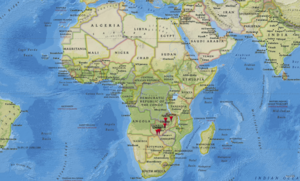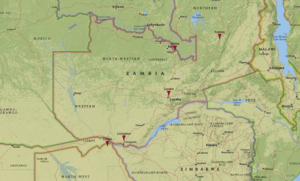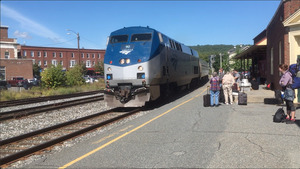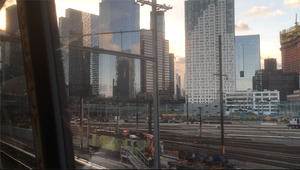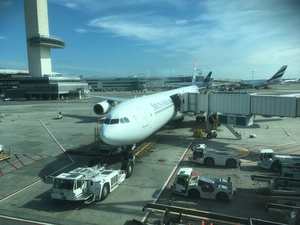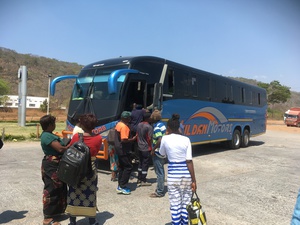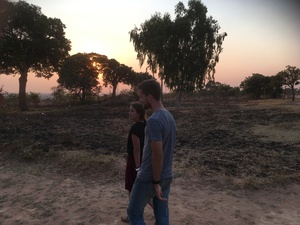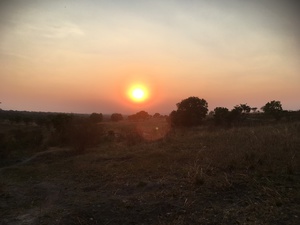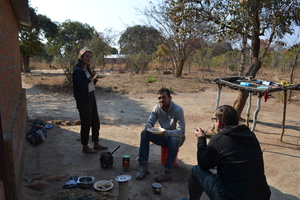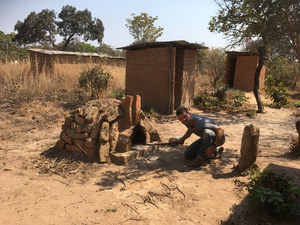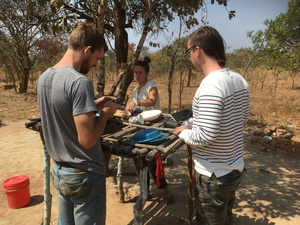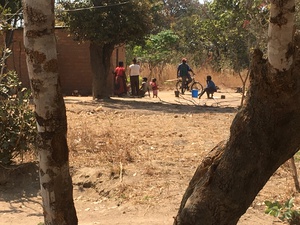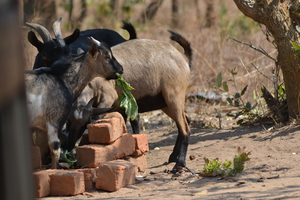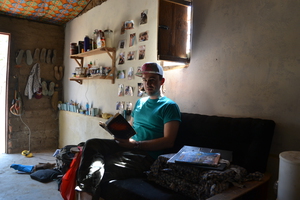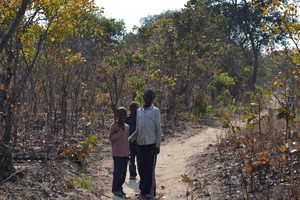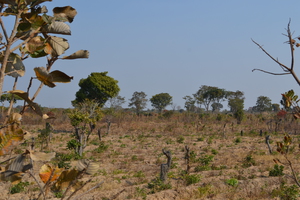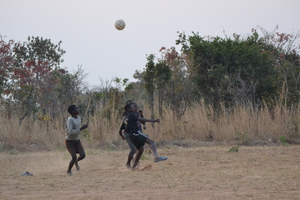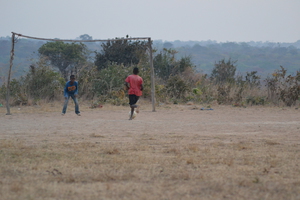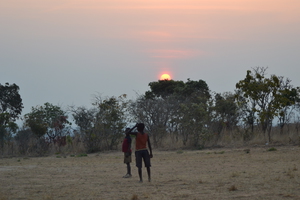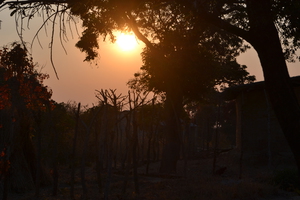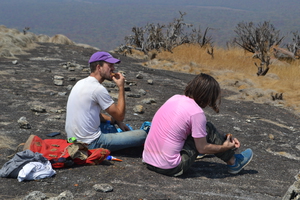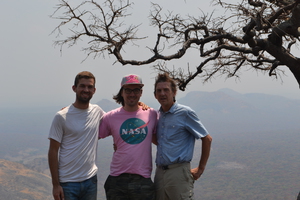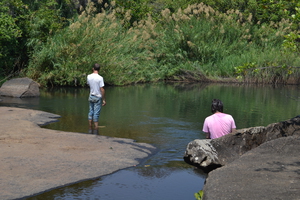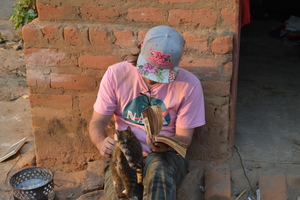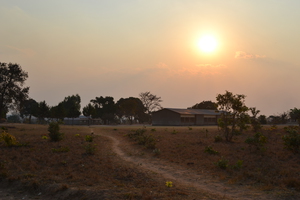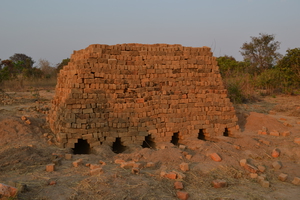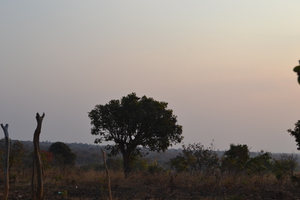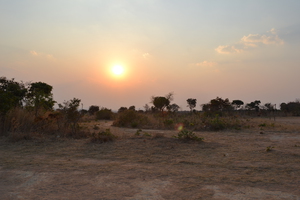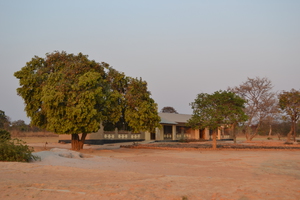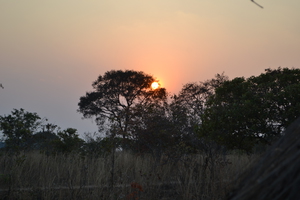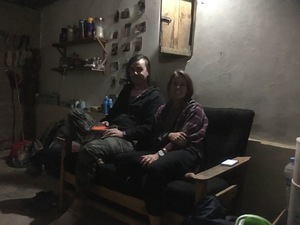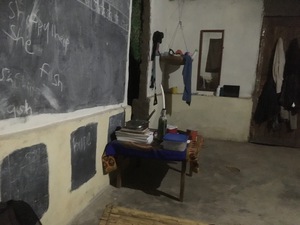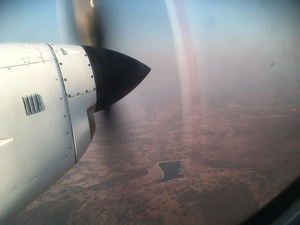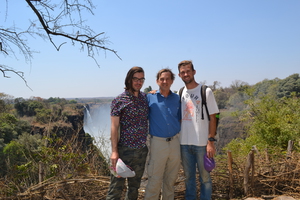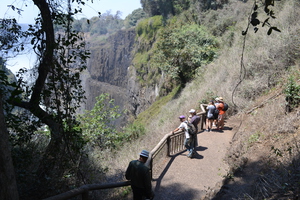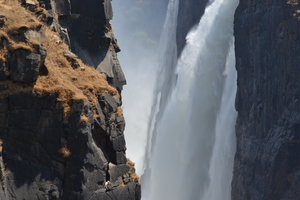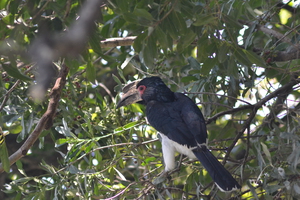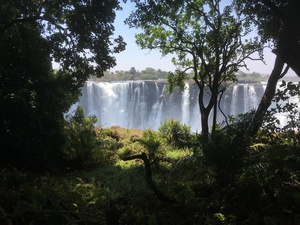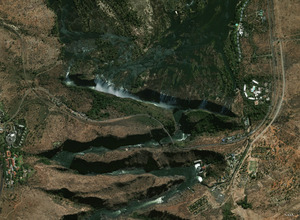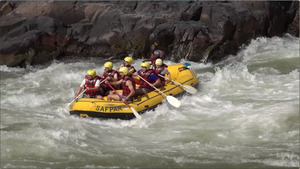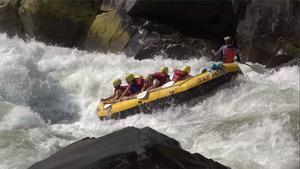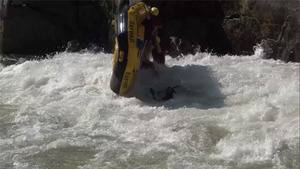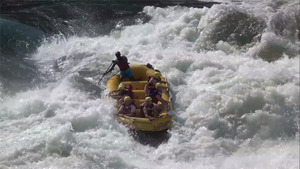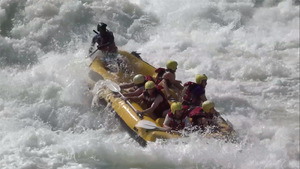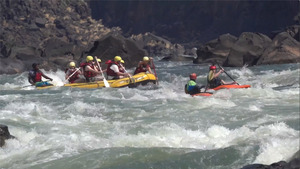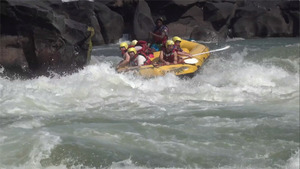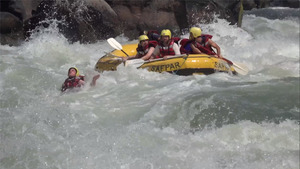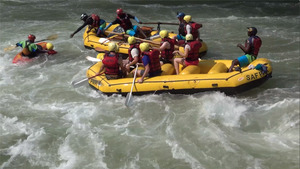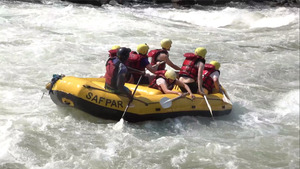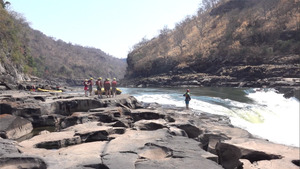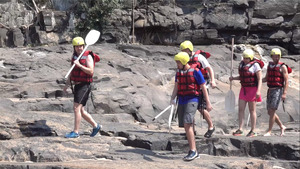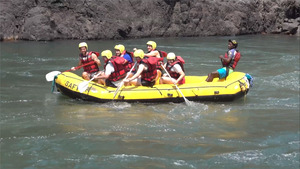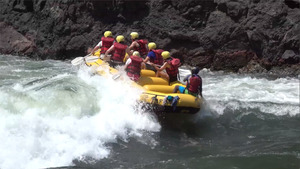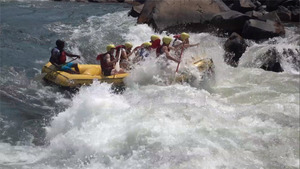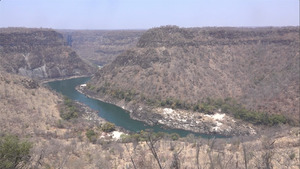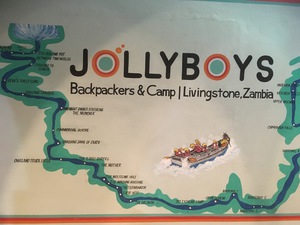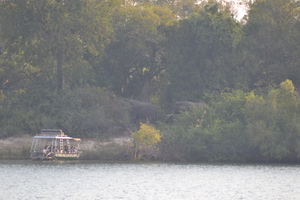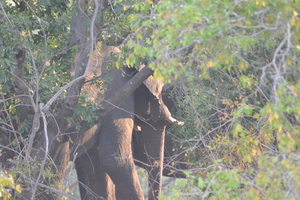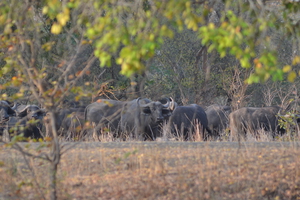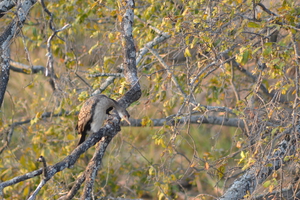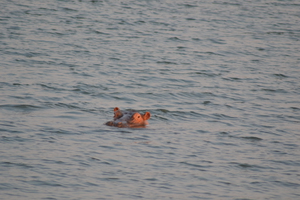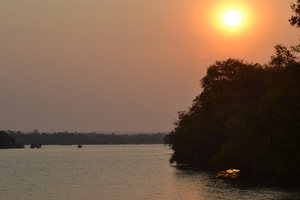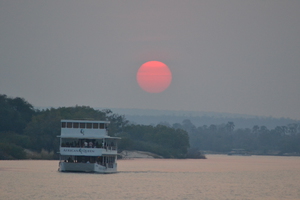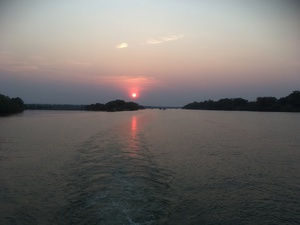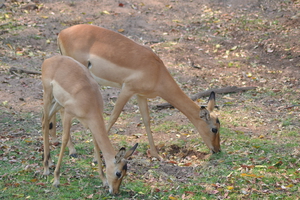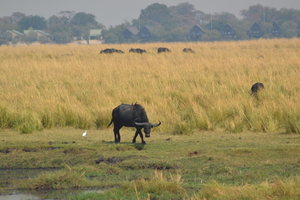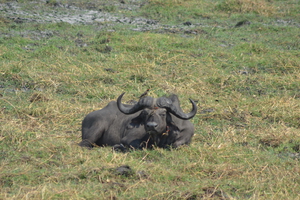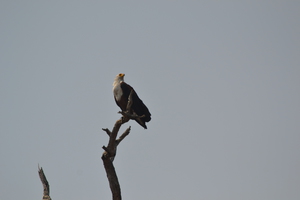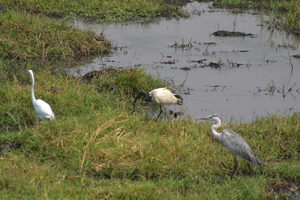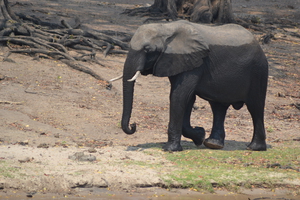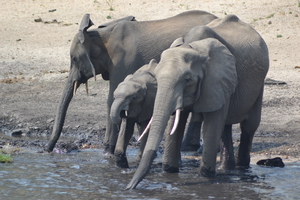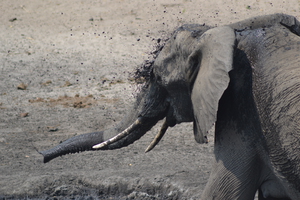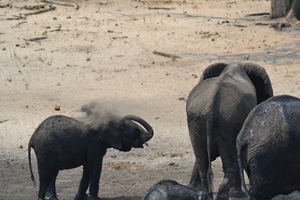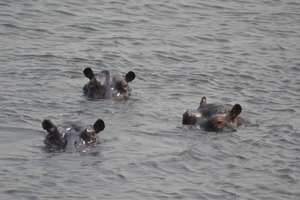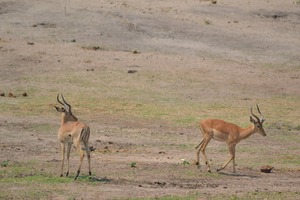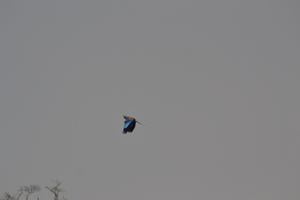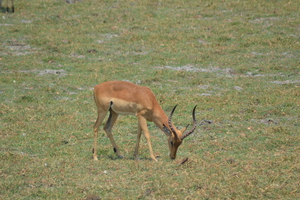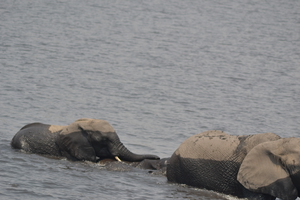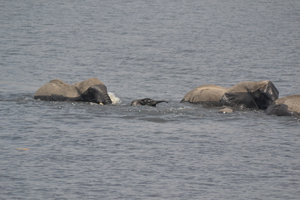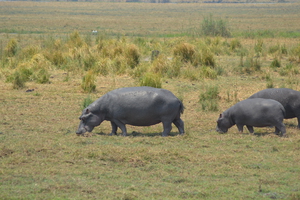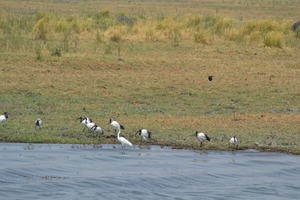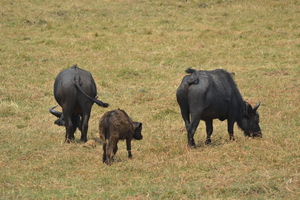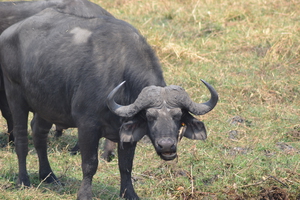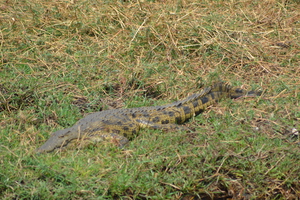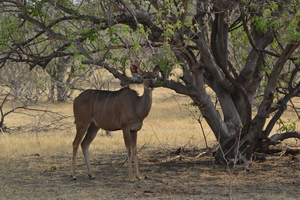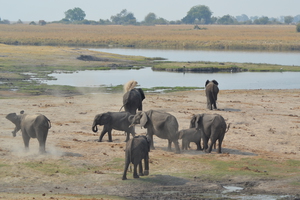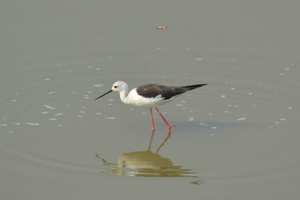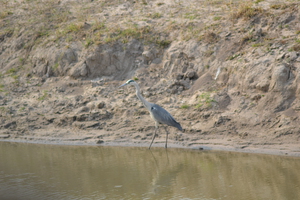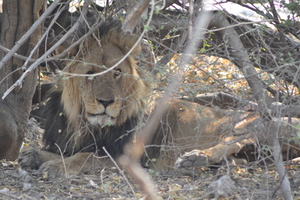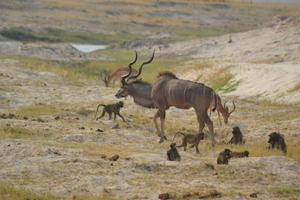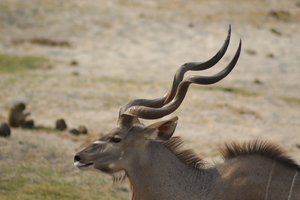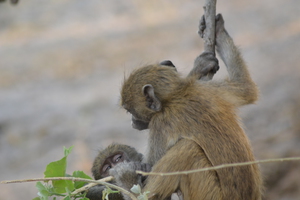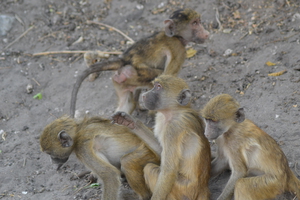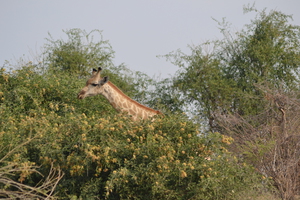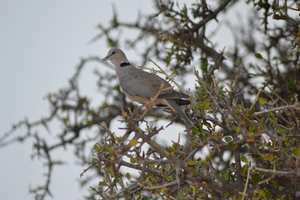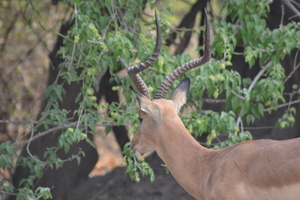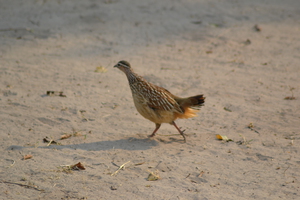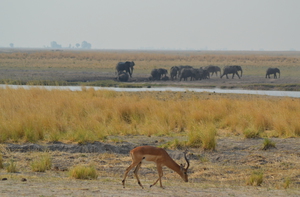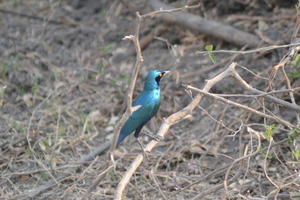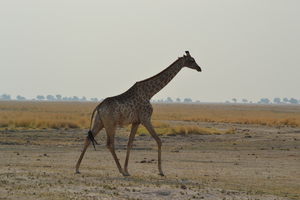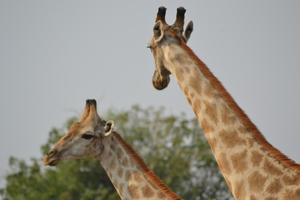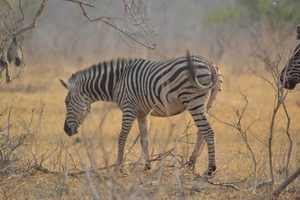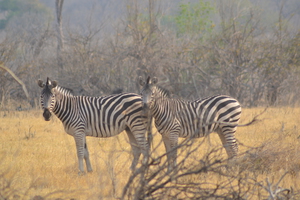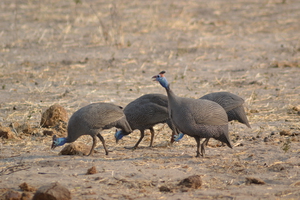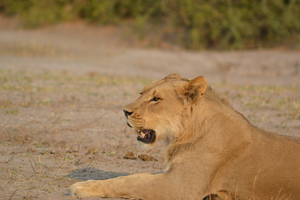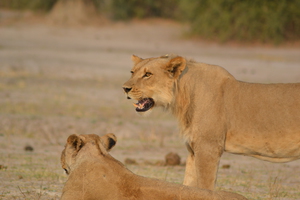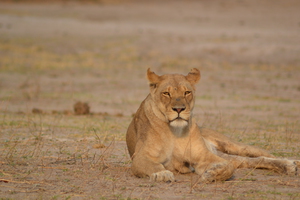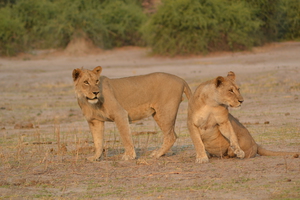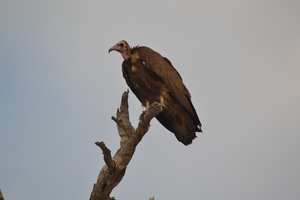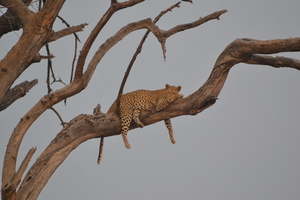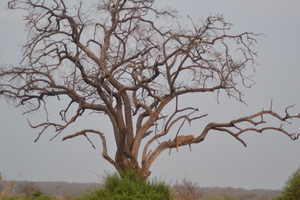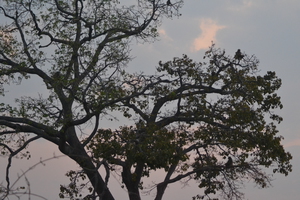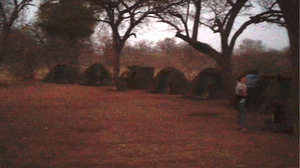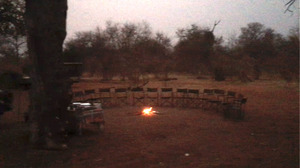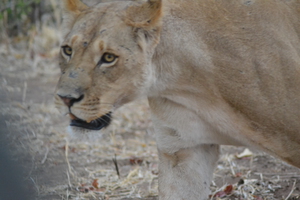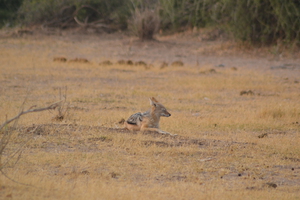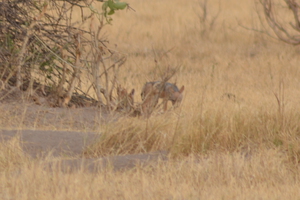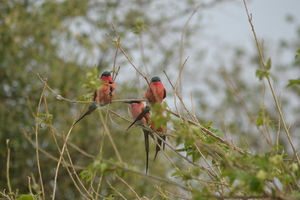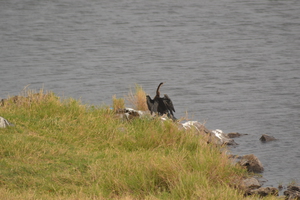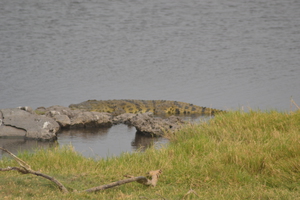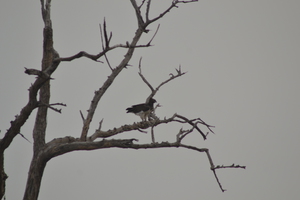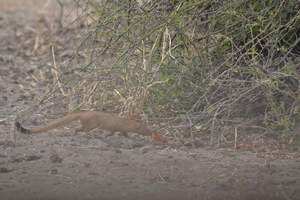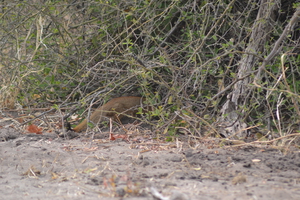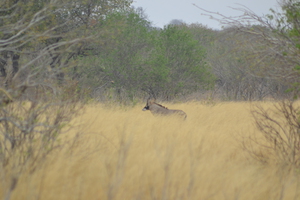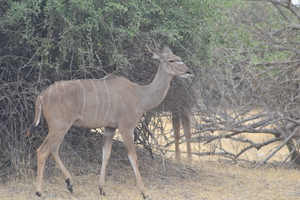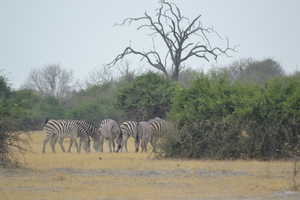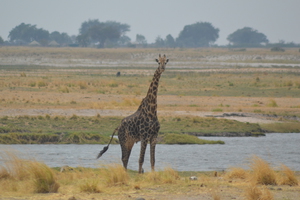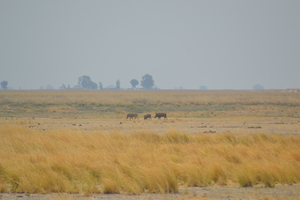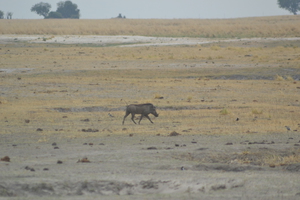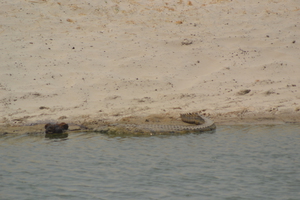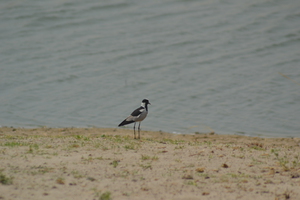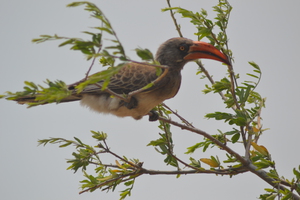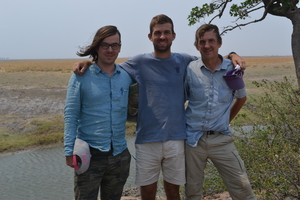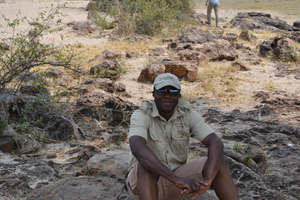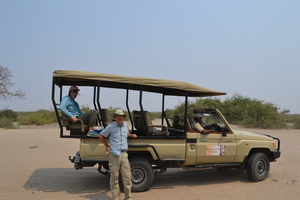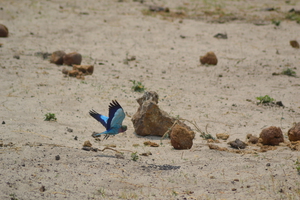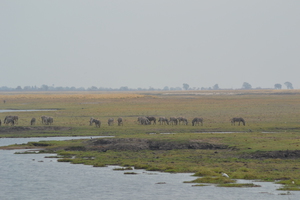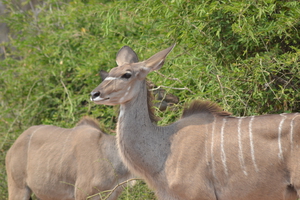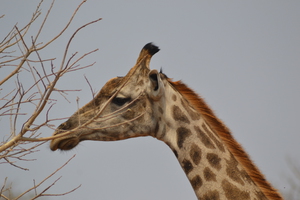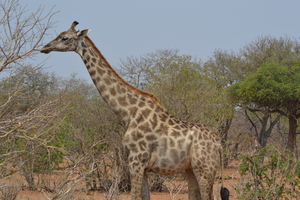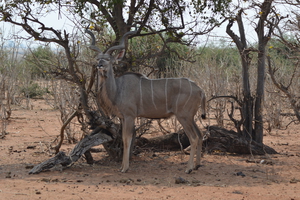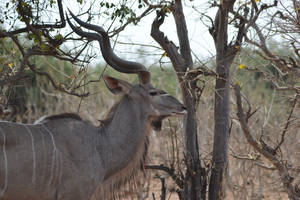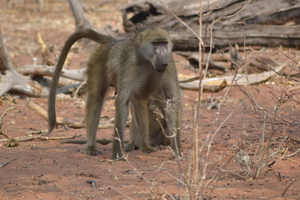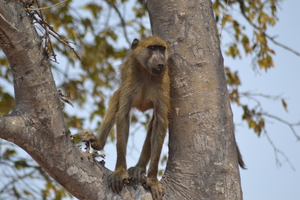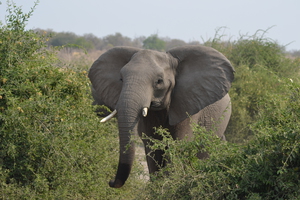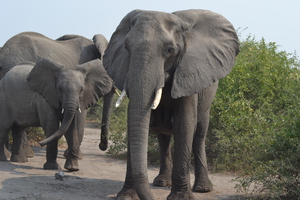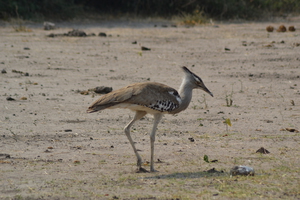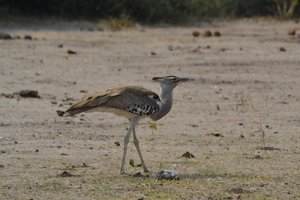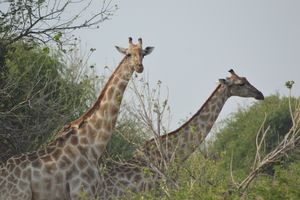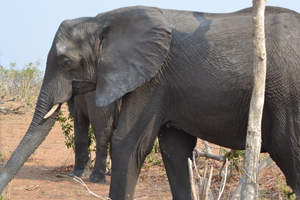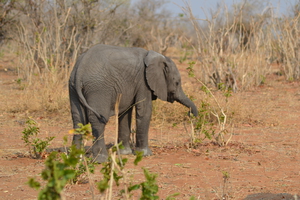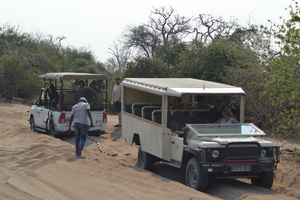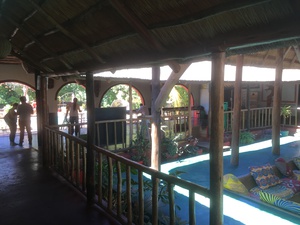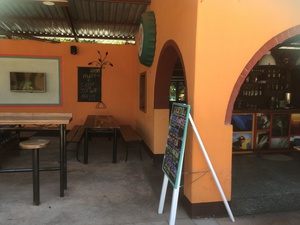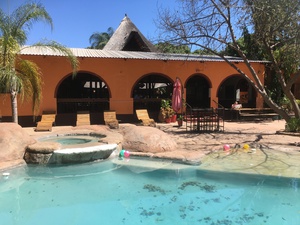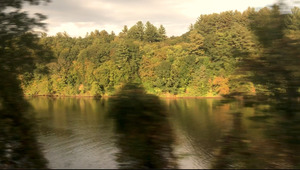|
Zambia & Chobe - 2019 September 13nd-28th, 20193 |
|||||||||||||||||||||||||||||||||||||||||||||||||||||||||||||||||||||||
[Click on any photo to get a higher resolution. Will, Robin and I had been out walking in the bush most of the morning. It was hot, dry and dusty. We then broke through a line of bushes on the shore of the Musamfushi River and came upon Paradise Pools. These splashing cool basins are well named. Soon our shoes were off, pants rolled above the knees and we were cooling our feet in the pools. At that point I turned to my boys and said to them, "Guys, we're in Africa!" It is such a simple statement, but I know it needed repeating, at least to me. Going to Africa is not that much different than going to the moon. It is a place that I only know through stories. Yet here we were, up to our knees in it.
Friday, Sept 13, 2019 I was walking from my house to the bus stop, where a bus would carry me to a train, the train to an airplane, and the airplane to Africa. Getting to Zambia is essentially the same as going anywhere in this modern world. It involves busses, trains and planes. The main difference between traveling to Lusaka vs. Los Angeles is the number of hours sitting in your seat. But it all starts by throwing a pack on my back and a duffle bag on my shoulder.
As I was walking up the street a colleague on his bike stoped to say hi. He noticed the baggage and asked me, "Where are you going?". That moment gave me pause, because I knew that what I was going to say would take him aback. "I'm off to Africa, to Zambia", I simply replied, trying to use the same tone I would have used if I had said I was off to the coffee shop. Robert was given pause and could only reply, "Wow!". He then offered his bike to take the duffle bag. The duffle is pretty heavy, as I am carrying forty pounds of reading material for Jane's school and new library. What I am carrying for myself is half that weight. What do I really need for this trip? I think the only unusual things I am carrying are malaria meds, a head lamp, a USB battery and a solar panel. I caught the local "Advance Transit" bus from Hanover to White River Junction, where I had an hour to wait. With the aid of a muffin and Americano I suffered through that trial, outside the cafe, in the sunshine. Amtrak train #54, the Vermonter was on time and the ride south was smooth and fluid. We clung to the banks of the Connecticut River. The valley is green and lush, the sun is bright, the sky is blue and travel is simple. I sent sometime talking with the woman who runs the cafe car. It is a curious life living between Washington DC and St. Alban, VT. Fourteen hour days in motion. The train rolled into New York's Penn Station two minutes early. Then I took the A-train and met Will in Greenwich Village. We went to dinner at a Georgian (think Caucasus, not peaches) restaurant. Will was then off to see friends and I wander the streets of Greenwich Village, an area Kristina and I knew well a few years ago. Eventually I found pie and happiness. Saturday, Sept 14 I went for a morning run, out to the Hudson and down to Battery Park. The city is full of people going places. My running watch has been glitchy the last few days and now has completely given up the ghost. I thought to myself, I'll just have to deal with this when I am back in Hanover. But then is occurred to me that finding a running watch here would actually be a lot easier than in the upper valley, and I also have no particular objective for the day. So in the morning I stuck my nose in half a dozen shops, asked a lot of questions, turned down a lot of suggestions, and eventually settled on the second-simplest watch on the market. Will and I also met with Nick O'Leary, a good friend of Will's, and former Hanovite and member of my scout troop. We had lunch and Will turned over his computers to Nick to hold while we go to Africa. Will has been living in NYC for the past month, but after this trip will return to the Bay Area. In the middle of the afternoon Nick texted Will to tell him his computers were lost on the subway. It will take awhile for the story to work out - but follow the advice from the Hitchhiker's Guide to the Galaxy (Don't Panic). Will & I met Jenna & Beth, friends from Will's college days, at Union Square and wandered off on a bookstore crawl, ending up with cupcakes and coffee for Fika. I now have a used copy of the "Hobbit", or "There and Back Again", to entertain me on long airplane and bus rides. Crepes at Le Grainne in Chelsea tonight. One of my favorite NYC cafes. Sunday, Sept 15
After a bagel breakfast at Murphy's on Sixth Ave we finished packing and headed to the airport. The flight starts just before noon, but time gets very confusing. It is a fifteen hour flight to Johannesburg, but we are also crossing six time zones flying towards the sunrise. So our flight rushes through the afternoon and through the night. It also means the flight crew have to work hard to get through a day's worth of meals! About midnight we can see the lights of Cape Verde below us. Monday, Sept 16 After having sighted Cape Verde I knew that we were not far from the western extent of Africa, so it was hard to imagine that we were in fact only half way to Johannesburg. The total flight is about 13,000 km, or 8,000 miles, and a little after sunrise we touched down. A few hours later Will and I were on a second flight heading north to Lusaka, Zambia and in the early afternoon we firmly set our feet in Africa. A week ago Robin had spent a few too many hours in the Lusaka Airport and got to know Jack Bunda, an airport employee. So Robin had called Jack and asked him to walk us through the system. Nothing was particularly difficult, but it was comforting to have a guide in this new land. Univisas, cash and sim card, then a taxis into the city. We finally met up with Robin at the "Natwange Backpackers". A "Backpacker" is essentially a type of hostel. He had just arrived after a long ride from Jane's village. To introduce us to Zambia he took us to the mall. This sounds odd, and it is, but there are a few things it is hard to get in Jane's village, and since we are in the big city . . . Meanwhile, back in New York City, Will's computer has been turned in to the lost and found. But Lost and found requires you to show up in person with an ID. Will is email Nick all sorts of stuff to help him claim the computers. After dinner we head to bed early. Our internal clocks are a bit out of sync, and tomorrow starts early. Tuesday, Sept 17 The alarm went off at 4:45 and we are packed and checked out by 5:15. A taxi takes us to the bus station for a 6:00 departure. There is very little light here, and most of that from bluish LED lamps, but the place is buzzing and it is hard to believe that the bus drivers and their stewards, with their thousand bits of paper, will shepherd us all onto the right bus, and get us heading in the right direction. But they do this every morning and so somehow it happens.
Robin tells us that the 5:00 bus is even more confusing. Busses are not allowed to travel at night due to a number of tragic accidents, but 5:00am is considered twilight. So lots of busses start at 5:00, bound towards the far corners of the country. On the outside our bus looks like a bus from anywhere in the world. On the inside I think a great many more seats then usual; smaller seats, have been installed. We are tightly wedged in. The Great Northern Road is filled with busses and great lumbering trucks, many of them hauling massive bits of machinery. Private cars are few and far between. The road itself is two lanes of asphalt, and our driver is constantly weaving his way around the industrial dinosaurs. North through Kabwe and Kapiri Mposhi, then northeast for hours and hours. We pass a number of villages which line the highway with market stalls, booths made of sticks lashed together. But I don't see a market. Is it the wrong day or time of day? Every few hours the bus stops and we have ten minutes to stretch our legs. And then, magically merchants with food appear. Many of our fellow travelers barter for food, but we have our bag of supplies from Lusaka. On the bus they play a few videos on the overhead screen. I find myself adverting my eyes, as these are often very violent. A curious selection from India and Indonesia, dubbed into English. As we get closer to Kalonje the bus steward keeps checking on us, as does one of the other passengers. I think the steward doesn't want to miss the stop and need to turn the bus around (I think they would), and the passenger wants to be a good host. And the rest of the bus can not believe that these muzubgu (white people) really are headed to Kalonje. Apparently there are two Kalonje stops and we are looking for the one near the rail station. Jane is waiting for us as we step off the bus, and most of the other passengers wave and bid us good-day. Jane is my son Robin's girlfriend and she is also a Peace Corps Volunteer, teaching English at the village school. It has been a long ride, nine hours, and she has a late lunch for us. She is also waiting for the vet to arrive, her dog, Mweleu, is very sick. Later Jane's neighbor, Judy, invites us over for dinner. When we arrive she is making nshima. ➤ Nshima (pronounced "shiva") Nshima is the staple of Zambian food. It is essentially corn grits. Start with a pot of water, boiling over a charcoal brazer and add handfuls of ground maze (corn meal). Stirring feverishly, keep adding more maze. Soon the nshima becomes thicker and harder to stir, but keep stirring. Apparently this is the moment which separates the novice from the veterans. When it is finally thick enough, remove it from the heat and with a broad wooden spoon scoop it out as nshima patties, piled on a plate for serving. Nshima is served with a variety of sides, or "relishes". Judy served up a dish of sautéed cabbage and a second one which reminded me of kale. Before eating, a bowl of warm water is passed around for hand washing. This is important, since you eat with your hands. To eat Nshima and the relish, you break off a piece of nshima and form it flat in your hand, then scoop up a bit of relish on it and eat. We are in the tropics so the sun sets at about 6:00 pm and twilight is short. So it is dim by the time dinner is ready and we move indoors. Judy and John's home, like Janes, is build of locally made bricks an a corrugated steel roof. It is divided into three rooms, a main room, a storage room, and a bed room. John, Judy's husband, is back from a nearby town where he has been at the bank, conducting the business of the farm co-op he heads. At some time soon the co-op will be selling most of the maze from the past season, which is bagged and stacked in their main room. They will then be buying fertilizer for the next season. The rains will come in about two to three months. John and Judy's home is also shared with Nellie, I think a niece, who is about seven and very giggly. John also has a pretty extensive solar array on the roof, with batteries in the main room, some lights and a satellite dish and a television. I find it curious what 21st-centry technologies they choose to embrace. We sat on a mat on the floor while eating dinner. Wednesday, September 18 No traveling today! We just walked around the village and shook hands with everyone. I liked the feel of the village, it reminded me of summer camp. Part of that is the smell of cooking fires, and part of it is that there is always the sound of children's voices. ➤ Kids & Schools Jane is teaching today, but has an odd schedule. The school is very full and works as best as it can to use its six classrooms. It is 1st to 9th grade and has two sessions, morning and afternoon. Jane's house is about 150 meters from the school, so we can see the stream of students heading to school early, or returning midday, or as part of the afternoon session. The kids are all in uniforms, although the uniforms don't necessarily match each other. The young kids all have very short hair, but the boys are in long pants and the girls are in dresses or skirts. I think one of my favorite uniforms were the girl's blouses that have a strip of cloth meant to look like a tie sewn on the front. Jane invited us to "club" at school. This is a bit of an experiment at the school starting today. The idea is that "club" would encourage some less academic activities. The session Jane is involved with, and we were invited to, was the girls-only club; a combination of fun and empowerment, helping the girls control their lives. There are about fifty girls, grades 1-9, all not quite certain what is going to happen. And then there are three old white guys in the corner of the room. They spent some time talking about the ground rules for a club, things like respecting each other, and then it was time to play. Even the foreigners got to join in with the human knot. And then "Duck, Duck, Goose!" Who knew it was such a universal game! ➤ Houses & Buildings All the buildings in Kalonje are build of local bricks, and the making of bricks is something that everyone is certain they know how to do. Just dig a pit, add water and straw and stomp around until the clayey mud is the right consistency, and then form bricks - usually in a mold. Let these proto-bricks dry, then stack them in a pyramid for firing. And after firing, it is time to build. Whereas it sounds so simple, I expect that the resulting brick is of middling quality. I say this because through out Kalonje I saw piles of broken and discarded bricks which seem to be dissolving back into the earth. Still, it is a handy material, and wood seems to be much harder to come by. Except for the occasional Baobab tree, I rarely saw a tree more than a six inches in diameter. This means the buildings are brick with a few bits of wood in window sills, doors, shutters and rafters. And in Kalonje almost all the roofs are corrugated steel. Jane's house is build of bricks on a concrete slab. It is subdivided into three rooms, a main room, a storage room and a bed room. It has two windows with shutters and bars, but no glass or screens, thus her cat, Rodriguez, can come and go as she pleases. As can the lizards, if they can get by the cat. Jane has two solar panels attached to a battery and lamp, and during the day we are always trying to move these into optimal sunlight. But since the climate is mild, a lot of life can take place outside, especially in the dry season. She cooks outside on a charcoal brazer. And, unique to Jane, she has a brick oven. This was Robin's project last winter. There are out buildings too. A pit toilet, a shower room (like the pit toilet, but with no hole in the floor, and a "insaka", which is a round, thatched, gazebo. I can imagine cooking in it in the rainy season. Cooking was pretty similar to a camping experience. All meal start with trying to get the fire started and neighborhood kids are always coming by to get a hot coal, or to offer one. With a glowing bit of charcoal covered with new charcoal you can try to get a fire going by adding air. But instead of blowing or fanning the fire, you can simply pick up the brazer - it has a bail, or handle, like a bucket - and swing is back and forth. Then we would all sit on water buckets and cook. Of course the neighbors were making Nshima, but Robin, Jane and Will created fresh tortillas and we had Zambian tacos. ➤ Running Jane invited me to go running with her, and I was delighted to put on my shoes and head out. She often goes running and the villagers have become use to her Western eccentricities. We headed out a dirt track, less than a Jeep trail, but more than a single track, to the north of the village. This is dry country in the dry season. All the grass is yellow. The farm fields are waiting for the rain and the ground is sandy, red and golden dust. The trees are spindly and stunted, I expect due to the perpetual demand for firewood. The air is thick with dust and smoke, for the farmers burn the grass to clear the land before planting in a few months and it is almost supper time and a hundred cook fires are burning. As Jane and I run, kids see us and join in. They all know Jane, for she teaches half of them. Even the non-students know her. No parent bats an eye at the idea of their eight, nine, or even five year old running miles from home. I expect that they are always near an aunt, uncle or cousin. And so as we run we gather a cloud of bare foot guides, as we head into the bush. They laugh and call out in a combination of Bemba and English. After a few kilometers it is time for us to turn back. Back by the school we stop to watch a soccer game. Robin has organized a pickup game on an all dust field under the burning evening African sun. All the boys from that part of the village are chasing the ball up and down the field. It is a special night with that tall white boyfriend of their teacher, and Jane has also released the special soccer ball. It is the only real soccer ball in town, acquired from the Upper Valley's "Grassroots Soccer" program. The girls don't join in. About a dozen, ages five to twelve, stand on the sidelines watching. Around the soccer field (football pitch) is a track. It is all dirt and has the occasional tuft of grass and weeds growing on it. I had missed my track workout, so felt obliged to run a few intervals. A few of the girls thought this very funny and ran with me for awhile. But as we came to the line to start my last interval I decided to challenge all of them, to goad them on and get them to run with me. I called and waved and used every gesture I could. Even if I didn't speak a word of Bemba, they knew what I was up to and all of a sudden a dozen girls started sprinting down the track. They thought it hysterically funny to run with me. I am older than most of their grandparents and with little effort they have passed me going into the first turn. Most of them slow up at that point, but I caught them, and pressed them as we entered the back stretch. Some of them thought this too funny and doubled up laughing, but four of them saw that I had tossed down the gauntlet and picked up the pace. I also had a few tricks left in my legs as we passed the 200 and 300 meter mark. I wouldn't let them relax. As we burst out from behind the tall grass at the west end of the track, with 50 meters to go, even a few of the soccer players paused. That last 50 meters is slightly uphill and three of us crossed the line together, gasping for air and with the greatest of deep belly laughs.
Thursday, September 19 I woke this morning to Judy's rooster's crowing, Soon Judy sent a pot of corn and peanuts to us for breakfast. The peanuts are not roasted, but instead they are boiled, at first I thought they were chickpeas. The whole dish is a thick stew and warms you up as we sat on Jane's doorstep and watched the sun rise, the day wake up, and kids head to school. We (Will, Robin and I) are going to the Mutinondo Wilderness today. Mutinondo is a privately owned reserve, about 10 to 12 km on a side, so about the size of a township. At 8:00 we are at the side of the highway and a flatbed truck from the reserve stops to pick us up. It is about 25 km from Kalonje to the reserve on bumpy dirt roads, but I expect our drivers does this a few times a day, and so ignores the washboards. At the main lodge the caretaker ask us if we are with the Pease Corp, like Jane. We confess our detachment and so pay full price. He gives us a map, suggest some walks, and we head out. The landscape is very different then Kalonje. Whereas the village is flat and dry farmland, here the landscape is broken up by great granite domes. The reserve's literature wants to call these "Inselberg". An Inselberg (isolated mountain) can also be called a "Monadnock", named after a mountain in New Hampshire. I personally don't think these really qualify for either of these terms; there are a dozen of them, so they are not really isolated. I'll stick with the term "granite dome". Between the domes are "Dambos", or "seepages", grasslands with surface water and even running streams! Our first stop is Mayense Rock, the highest dome in the area. It rises about 200 meters above the surrounding land, and is mainly bare, exposed, rock. It is windy on top and we pause for a while and enjoy the vista. Below the dome most of the land is covered with a forest of thin and spindly trees, broken up with swatches of grasslands in the seepages. I would like to name the trees of this forest, but think I'll just confess that later I read that this sort of environment is called a "Miombo Woodland", trees widely spaced with tall grass between. After talking and eating on the dome, we continued to Hyrax Hill and some petroglyphs. We then circled north, crossed a few seepages and streams and eventually found "Paradise Pools". After being in the sun, and walking on dusty trails, it was a delight to take off our shoes, role up our pants and wade into the cool waters of the pool. Right now, in the dry season, there is a very strong line between green and lush plants within a few meters of water, and the brown, dried, hard grass and leaf-less trees beyond the seepages. While standing knee-deep in the pool I turned to my sons and saids, "Guys, we're in Africa!" I then went on to explain that I was reminded of a scene in "Hitchhiker's Guide to the Galaxy" were Arthur has been complaining about things being inconvenient, when Trillium turns to him and says, "We're on a spaceship Arthur!" All those things like heat and dust and long airplane and bus rides and limited lights and new and different food are all trivial when compared to the astonishing fact that at this moment we are wading around in a most pleasant, well-named pool in the middle of a miombo woodland, in the the Mutinondo Wilderness, in Zambia, in the most central heart of Africa. Africa is that most mysterious of continents, a place which we only know of through the stories of Victoria missionaries and explorers and novelist. And we are cooling our toes in cool waters! Back at the main lodge we have a really nice late buffet lunch, looking out over the forest, with wandering and slow conversations followed by a bumpy and quick trip back to Kalonje. As the day winds down I wander around the village. I go over to see the foundation and the pile of bricks for the library. I watch women and children fetch water from the well. Will has found a friend in Jane's cat Rodriguez. Judy has asked us over to dinner again and has even slaughtered a chicken for us! This is really a big deal as Judy's chicken coop and run is a demonstration of their wealth. As Jane described it, it is their bank account. As we head to bed we are looking for tomorrow's driver.
Friday, September 20 Kalonje - Ndola - Livingstone Ronny, our driver, arrived at about 10:00 last night and declined the offer to sleep on the floor (next to Robin & Jane), and instead slept in his car. All of us are up at 4:30. Robin, Will and I are packed by 5:00 and Ronny is speeding us down the road a few minutes later. It is about 500 km to Ndola and our flight.
The trip is without incident, except for one stretch of the "Great Northern Road", where the pavement is missing for a few hundred meters and vehicles are left wallowing in the sand. We swim through the mire, passing a truck which is stuck there with its crew camped next to it, and are soon again speeding down the asphalt. Ndola is in the "Copperbelt" district, the most industrial city I have seen in Africa. After buying food, a late breakfast, we are at the airport in plenty of time. The terminal clearly started life as a Quonset Hut, but has had a dozen additions of various sizes and shapes grafted onto it. Robin is concerned that his pack, the one he is living out of for two years, may be too heavy. The weight limit is 23 kg and his pack tips the scale at 23.8kg, but the woman checking us in is happy to weigh all our bags together, which is well under the limit. It is a one hour flight on Proflight-Zambia to Lusaka where we cross paths with Jack, the guy who helped us in our first hour in Zambia. We have a 2-3 hour layover here which we spent in a cafe. One member of the group next to us was reading a book called, "Where the Crawdad Sings", about growing up in the marshlands of North Carolina. They had never heard of a "Crawdad" and were speculating as to what it might be. I gave them my best description and told them that as boys, my brothers and I would catch them. We also sometimes called them "mud puppies". The group were in Zambia for a wedding, but were visiting from England, South Africa and New Zealand. We also met Molly here. Molly went to high school in Hanover between Will and Robin. I think I was told that she and Ari Brown went to the prom together. She now works for an NGO in Lusaka and will be spending the weekend at the same hostel we are heading to. Another one hour Proflight-Zambia flight and we are in Livingstone. At the airport there are a number of helicopters and later our driver explained to us that the President of Zambia was in town. This region is suffering from a drought and he is there to hand out aide. We were told that he was reluctant to declare an emergency because that would trigger all sorts of other things. "Jolly Boy's Backpacker's Hostel" has a van which meets are flight and we are soon at the hostel. The hostel has a bar where you can also order food, and we are a bit weary from our travels and so eat in. At 7:00 we FaceTime with Kristina, it is her birthday. Then showers and bed. Saturday, September 21 The hostel offers a shuttle to Victoria Falls (10km away) at 10:00. So we are up at 8:00 and Robin and I walk downtown, three blocks away, to do some grocery shopping. The grocery store is far closer to an American experience than to shopping in Kalonje. Busy with lots of shoppers, it is definitely an urban experience. But they are woefully lacking in good coffee; we turned our noses up at the array of instant caffeines. We had also noticed a coffee shop between here and the hostel, so bought real coffee on our way back. The hostel has a guest kitchen which contains a rack of wire-basket like drawers and a common refrigerator were we can keep food. After oatmeal, toast and coffee we board the shuttle and head towards the falls.
Victoria Falls is called "Mosi-oa-Tunya", "The Smoke That Thunders" in the local language. But I think the people who live here understand the importance of tourism, and the fact that very few tourist have ever heard of Mosi-oa-Tunya before arriving. The falls is on the Zambezi river, which forms the boarder between Zambia and Zimbabwe, and the best spot to view it is from the Zimbabwe side. So the shuttle dropped us off a hundred meters before the Zambia customs and immigration station and we walked through immigration, across the bridge and through Zimbabwe immigration. Both sides of the boarder are choked with trucks trying to get through customs. Since I rarely see a truck in motion I wonder how many hours most of them sit here. For us walk throughs, we meet an officer who looks at our passport, checks his or her computer screen, then stamps our passport and we move on. Since we got a "univisa" when we entered Zambia a few days ago we have no extra fees for a day crossings. Still the lines are long and slow. The bridge itself is curious, sandwiched between two nations. There are taxis which will carry you back and forth between custom stations. There is bungee jumping from the middle of the bridge. And, of course, there are people ready to sell you tourist souvenirs. One of the most pervasive souvenir it the Billion-Zimbabwe-dollar bill. Zimbabwe suffered hyperinflation a decade ago, and these bills, even back then, were not worth the price of the paper. "But wouldn't you like to be a billionaire?", the hawkers asked us. I think the most amazing thing about Victoria Falls is that the gorge it plunges into is perpendicular to the direction the river flows. This is different than Niagara. At Niagara you might stand at the edge of the gorge, maybe 800 meters (half mile) downstream and look up the gorge to see the falls. Here you stand 100 meters in front of the falls, and look ACROSS the gorge to see it. The falls is taller than Niagara, but it seems even taller since from most vantage points you can't see where it hits bottom, someplace below you. The other thing about the park which surrounds the gorge is that it is so lush. We are in the dry season here and have got use to withered plants and lots of dust. But next to the falls is a perpetual mist forest, a true jungle extending 40 to 50 meters from the edge of the gorge. One last point of comparison which struck me; the park on the Zimbabwe side of the falls is called "Victoria Falls Park", (the Zambian side is called "Mosi-oa-Tunya"). The park on the Canadian side of Niagara is called "Victoria Park". And both are in some sense gardens. One bird in particular caught our attention and the boys sent a photo of it to my father. Granddad quickly identified it as "some sort of Hornbill". Even though he had never seen a hornbill, he told us it was distinct. Later he text us to say it was a "Trumpter Hornbill". Amazing to have your ornithological authority online across the equator and an ocean. After awhile we walked into the town of "Victoria Fall" in search of lunch. I think this is even more tourist dominated, and more English than Livingstone. Next to where we ate is the station for an excursion train, vintage Cecil Rhodes and Queen Victoria. But what I liked best was watching the monkeys race across the roof tops of the railroad cars. Will and I try the trio-sliders; crocodile, impala and beef. And lots of lemon ice tea. Back in Livingstone, in the evening, we walk out to Olga's Kitchen for pizza. Sunday, September 22 We are being picked up at 7:30 to go rafting, so are up and making breakfast at 6:30. A van takes us to the rafting center where we are fitted with lifejackets and helmets, and leave valuables in a locked box. Then the van carries us to the falls, just before the bridge and customs station. Here we descend into the gorge, a few hundred meters below the base of the falls to a place called "The Boiling Pot". A bit more about the falls and gorge as a geological curiosity. The overall flow of the Zambezi River is west to east, but for a few miles, near the falls it flows south across a great basalt (volcanic flow) formation. This formation has a number of east-west defects and folds which have caught the river, forcing it back and forth in a zig-zag pattern. This means that the Batoka Gorge is divided into a number of shorter sections with such descriptive names as "first gorge", "second gorge", and so forth. Our trip will carry us through five of these gorges and over 21 rapids, most of them class V. The Boiling Pot is the first bend in the river below the falls, where the first and second gorge meet. There is an eddy here so you can launch a raft without being quite ready, because the river will just push you round and round until you are ready to paddle on. There are six crew and one guide in our raft, and another visitor in a kayak. We are accompanied by one other raft and two more kayaks as required for safety. There are also a few guides floating the river on boggy board, apparently it is their day off and they are along for the ride. The other three tourist in our raft included a Canadian and a pair of cousins from Brazil. The kayaker is a river guide from New Zealand who tells us that he hopes to run these rapids almost every day during his two month visit. The rapids really are amazing and thrilling, but definently not for the faint of heart. There is so much power in this river! The same amount of water which cascades over the lip of Victoria Falls also passes through this rapid every minute. Clearly it has the power to crush a boat if it can get its hands on us. But a raft is too slippery for the river to entangle. We splash and speed through in an adrenaline rush. At the fourth rapid, "Morning Glory", our raft is flipped. While watching the video afterwards we noticed that our guide, Floyd, was actually the first one knocked out of the boat. In my memory I see it as a slow-motion roll, and when I think things have settled (up-side-down) one final tug and I lose my hold on the raft and go floating down the river. For years I have been told that in the situation get your feet downstream of you incase you encounter rocks. Now I had a chance to use that strategy. Soon one of the kayaks catches up with me and I was back with our raft in a few minutes. A few rapids later, at "Gullivers Travels", an odd bump knocked me overboard, but nobody else. I sometimes wonder if my death-grip on my paddle was part of the problem. When I am paddling my kayak on solo trips I am aware of the importance of not loosing a paddle. I could stitch up and repair my kayak, but a lost paddle is a lost engine, thus the reason I carry a spare. One of the rapids is well beyond our ability. We let the raft drift through, and walk around. River guides must have fun naming the rapids; Stairway to Heaven, Devil's Toilet Bowl, Midnight Diner (including The Muncher), The Three Ugly Sisters, The Washmachine, etc. Near the end of the trip, as the rapids became a lot more tame, we sometimes jumped out of the raft and floated in our life jackets (personal flotation devices) down the river. Eventually, even the rapids of the Batoka Gorge run their course and by 1:00 we are hiking up a trail out of the gorge. On the trip back to town we pass through a very traditional village and I wish I had my camera with me. Most of the kids are calling to us and the guides are tossing them the unused water bottles. The guide sitting next to me tells me this is his home village and points out his parent's home and that one of the runners is his cousin. Monday, September 23
This is a day of rest with the only planned activity a dinner/sunset cruise on the upper Zambezi. In the late morning Robin and I go out for a walk around the city, ending up at the "Cafe Zambezi" where I have goat stew. It is VERY spicy! In the evening we are picked up and taken to the same place where we were equipped for the rat trip. This time, however, we are on a big boat heading upstream, about 4 km above the falls. The river is broad and slow moving here. There are a number of other boats, pontoons and multi-decked, like ours, doing the same thing. The boats wander from shore to shore as we see elephants, hippos, crocodiles, monkeys and cape buffalo. I feel like I recognize the families, the genus, of some of the birds, but not the particular species. Hors d'Oeuvre and drinks on the upper deck. Later a buffet dinner on the lower deck. And then we watch the sun setting into the river. The power was out when we got back to the hostel. But we had our headlamps and hostel's bar was in full operation even when lit with but a few lamps.
Tuesday, September 24 Getting too Chobe is a bit complicated. We are up early in the twilight to pack overnight stuff, and then the van is ready for us at 7:00. It is about an hours drive to where Zambia touches Botswana at the twin border towns of Kazungula. The countries share a border of 150 meters! We go through the Zambian exit immigration, then get on a boat to be ferried across the Zambezi River. Like at Livingstone/Victoria Falls, a hundred trucks are waiting to cross the border, and two larger ferries are working hard to move them, but at only two trucks at a time. A modern bridge, now only half finished, spans the river overhead. The people-ferries carry one or two dozen people at a time and are mainly chartered by tour companies like the one we are using for this Safari. On the Botswana side we again go through customs and immigration and then meet with our tour company; "Kalahari Tours". All told it took about an hour to cross the boarder. "Kalahari" is one of the place names which conjures up all sorts of images. In truth, Chobe is in the Kalahari Basin, but not in the Kalahari Desert. Still, the name on the side of the Land Rover gave me pause. Our first stop is the "Kalahari Buzz", a coffee shop which also serves is the hub for this tour company. Here we had a second breakfast while the arrangements of various tour groups were being checked. Most people are here for just the day. Behind the "Buzz" cafe is a path to the Chobe River where a boat awaits us. It is a big pontoon boat with both an upper and lower deck. We started just above the confluence of the Chobe and Zambezi, and traveled upstream from here. We were on board for about 3 hours, but may have only traveled 8-10km. Cape Buffalo, elephants, hippos, impalas and lots of birds! I think the high point of the cruise was watching the families of elephants, especially the way they coddled their babies. One group came down to the river bank to wallow in the mud. They splashed themselves first with water, then with mud, then finished off by dusting themselves with dry sand! It is amazing to see them use their trunks. Another group of half a dozen, including a one day old baby, crossed the river in front of us. The adults could walk on the bottom of the river with water up to two-thirds of their height. But the baby was clearly hesitant and clung to its mother. Eventually the mother wedged the baby between two other adults, and then pushed from behind. Only its trunk showed for awhile, like a snorkel for breathing. Hippos! Such an unlikely animal. As Will described them, "Manatees with legs". Most of them are in the river, with just their eyes and nostrils showing. Occasionally we see them ashore. Bulbous bodies with squat legs. Jensen, our guide, described the Cape Buffalo as "angry old men". However, let a bird perch on their back, and that angry expression becomes a bit ridiculous.
After the cruise we were back to the cafe for lunch. Here Robin asked about a hat and glasses that a friend of Jane's had left here. "Yes", they had been found, but were presently cruising around the bush of Chobe in a Land Rover. In the afternoon we headed out in a truck into the park proper and onto some dirt and sandy roads. We meet a group coming out who are mired in loose sand. I am struck with the realization that there is a lot of similarity between driving in sand and snow. Some vehicles are better at it, but so are some drivers. Some drivers can judge what conditions will support you and which ones don't. Also, managing momentum is important, and spinning your wheels is a bit of desperation. Later we pass a dead elephant. Its tusk are missing and our guide tells us that it looks like a natural death since there was no apparent gunshot wound; poaching is a real concern here. He said that the game wardens will take the tusk to discourage the blackmarket ivory trade. Robin told us that in Uganda they have recently re-introduced the rhinoceros, each one with a 24-hour warden to protect them against poachers. Rhino horns are highly valued on the traditional Chinese medicine blackmarket. Up to this point we have been in the backcountry, high plateau, "bush". We now dropped down into the Chobe River valley. There is a much higher concentration of animals in the river basin, especially now in the dry season. Some animals will move back into the bush at night. I think this area may still be classified as "Miombo Woodland", but it is becoming more "Savannah" like, with the trees and bushes wider spaced them near Kalonje, and more grasslands. But the thing which caught my eye was that almost every tree had broken limbs hanging from them, or scattered on the ground below them. Our guide later told us that this was due to elephants crashing through them. The Chobe National Park has the highest density of wild elephants of any place on earth, and the trees show it. At the "picnic area", complete with picnic tables and washrooms, like any national park, we met up with another truck from our tour company. Supplies and passengers are redistributed, and we start out on the core of our safari. Our guide is Richard, and I would highly recommend him. He was excited to show us a lion and so we bumped off down the track. All these roads are four-wheel drive, high clearance only. Rocks, boulders, occasionally short steep climbs around obstacles, washouts and lots of sand. The flood plains of the river are mainly grass lands, with the occasional tree on hillocks which are probablely islands in a flood. On the edge of the grassland is a tangle of trees, now mainly leafless in this season. And under one of these trees, concealed by a snarl of bushes and vines, is a great lion, napping in the afternoon heat. We are told that you can tell he is older because of the black in his mane. He lifts his head to watch us for a few minutes, then rolls over, feet up, and goes back to sleep. Like a house cat in a lazy sunbeam. More birds, including great big guinea fowls, locally called "Chobe Chickens", fish eagles, and more. As well as more cape buffalo and flocks of impalas. We also see Kudos, famed for their spiral antlers which can be made into horns and were blown at the South African World Cup a few years ago. At one point we spot three other tour trucks and go to see what ever they see. They are surrounded by a pride of lions. Richard tells us that this is a "Boy's Club", all young males. There are seven of them, and they seem particularly lazy and have very little interest in us, even though we are only about 30 meters from them, and our vehicles are all very open. We spent a long time watching them, but eventually moved on. Later, while driving through a remote part of the bush we encounter another tour truck. "Robin?", they asked. And when we say "yes", they hand over Jane's friends hat and glasses. Near the end of the day Richard took us to the extreme west end of this area and we see a leopard in a tree. We have seen the skeletons of impalas in trees before; leopards pull them up into trees because if left on the ground lions will steal them. This leopards is a lazy cat. Spotting one is so rare that Richard radios other guides and soon four other tour trucks join us. Around sundown we return to our camp; tents, thick sleeping pads, sheets, pillows & duvets, wash basins, chairs, fire and very soon dinner. There are about fifteen guest, two guides (Richard & Kennedy) and two camp staff. The camp is surrounded by half a dozen kerosine lamps which burn all night to discourage wildlife. We are warned that if we head to the latrine at night, first scan the bushes with your flashlight. If the light reflects on eyes, you probably really didn't need to go. We talked around the fire for a long time. The stars are out. But what I find curious is that there are no bird or insect noises; it is so very quiet. Late in the night, at a distance, a lion rumbles.
Wednesday, September 25 At first light I hear the camp staff coming by with warm wash water. They tip over the canvas basins which are outside of each tent and slop in new water in from a bucket. There is often early morning animal activity, so after first breakfast we head out - about 6:00am. Not more than 200 meters from our site we meet the pride of lions, the seven young male we saw yesterday. It is a brief encounter, the lions are headed into the bush and show little interest in entertaining us. Not long after the lions we arrive in an open meadow and spot a jackal, laying across the mouth of its den. Eventually two kits (they look fox-like) or pups emerge from the den and romp and play, with their proud parent watching. Despite their reputation, jackals seem no more menacing than foxes. They are about the size of a small coyote and, to us, exhibit a strong family life. One of my favorite stops this morning was when we drove out into the flood plains of the Chobe River and stopped on a knoll with a few trees. We were looking for a heard of cape buffalo, they graze in this area like cattle. But they are not here today. Still, I enjoyed walking in the tall grass. It felt very prairie like. We circle back to the camp for a second breakfast. Since we have Richard to ourselves for the rest of the day, we stow lots of water and a few snacks, and opt to forgo lunch. We have been well fed. Brilliant red "bee catcher" birds, fish eagles, pelicans, the list goes on and on. Ever time Richard points out something new Will is quick to record it in his notebook. Robin has taken over my camera with the telephoto lens. I've told him I am going to leave it with him for his time in Africa, so this gives him a chance to try it out. Crocodiles, cormorants, zebras, giraffes, buffalo, kudo; the list continues to grow. At one point we see a mongoose, which looks like a stretched gerbil. I tell Richard that in our literary tradition mongooses are known because they will kill snakes. Richard says that yes this is true, and he knows people who have mongooses which are happy to take on a black mamba, a particularly venomous snake. We need to be back at the boarder crossing and ferry at 4:30 to make connections, and so at about 2:00 we start to head out of the park. Robin mentioned to Richard that if they was one more things he wanted to see it would be an elephant close up. As if by appointment, we rounded a corner in the bush and nearly collided with a herd of elephants. The biggest and most fierce looking shepherded the rest of the herd behind some trees and bushes and then filled the gap, facing out towards us. With great flapping ears, the shaking of its trunk and a mild bellow it warned us away. "Don't even think about getting any closer." A few miles later we encountered a herd of maybe fifty impalas who were hissing. Richard stopped and we watched. Apparently a leopard had tried to sneak up on them, but they were on their guard. I was watching a giraffe and could tell were the leopard was by seeing were the giraffe was looking. At one point we saw the leopard dart between two bushes, but the impalas were going to deny him dinner today. As we approached the exit of the park we met a tour truck coming in which was mired in sand. Richard turned to us and said he would like to help. We replied that of course that is what we would do. If a vehicle was stuck in snow, we would do the same. I then realized that half a dozen other tour trucks passed us without offering help. Richard had a thick nylon webbing for towing stowed under his seat and we assisted. I think the driver of the stuck truck was very in-experienced and kept killing the engine. When I pointed out the unloading of the truck would help, the ten tourist aboard saw the sense of this and all got out. But the driver kept calling, "Ladies stay in, ladies stay in!" As Richard towed, the boys, many of those tourist - including the ladies - pushed, and soon we had that truck un-stuck. The tourist had been a bit frantic, and now were so grateful that they took up a collection for Richard. Dealing with problems and the unexpected is what makes an adventure, I explained to one of the elderly ladies. They were no more diversions and we were at the border at about 4:30 and an hour later were climbing into a van headed towards our hostel. We opt to eat at the hostel tonight, despite the power outage there. Thursday, September 26 After the safari, the rest of the trip is a bit of an anticlimax. Today we have no particular plans beyond hanging out in Livingston and packing. But the morning starts with a small crisis; we have used up all of our coffee and most of our groceries. So despite planning on not moving this morning, we all take a walk downtown to a coffee shop. Three Americanos, two meat pastries and a scone. Afterwards Will and I decide to explore on foot and walk a ways through town. We meet some sort of parade or protest forming up. It was led by a brass band in military camouflage, followed by people carrying signs about social justice.
We eventually passed through a very upscale neighborhood with lush gardens, but all well protected by iron gate and walls. We discussed why in some places a "compound" is normal and in other places it is not. On our return we passed though a local market. I expect main street shopping is so tourist oriented that they needs to be a second shopping district for people who actually live here. In the early afternoon Robin walked with me an we had seafood for lunch. We also encountered a march, this one seemed to be aligned with a church, and proclaiming the need to protect traditional values. I would like to know if the too marches collided. Later, we walked by the railroad museum, and were engulfed in a crowd of school kids heading home. Our last dinner together is on the veranda of a fancy Indian restaurant.
Friday, September 27 A travel day. A mid-day flight to Lusaka where Will and I say goodbye to Robin. We have a long layover here and are tempted to hang out in a cafe for a while. But Will points out that airport lines in Zambia can be painfully slow. It is a good thing Will pushed us. We got through check-in and security and to our gate only ten or fifteen minutes before they started boarding. In Johannesburg we again have more entrance and exit visas. But one thing about all these airports is that it gradually moves us from rural Africa to a cosmopolitan western environment. The Johannesburg airport is almost indistinguishable from an American shopping mall. We board our plane at 9:00pm. It is a fifteen hour flight to New York City. I am carrying some stuff which Robin no longer needs, including the book "Boys in the Boat". I left my copy of the Hobbit for the Kalonje Library. Saturday, September 28 I would like to close my eyes in South Africa and open them in New York, but I don't sleep very well on airplanes. It is a long night, elongated by six time zones. At daybreak we are over Long Island and soon drop into JFK. Through customs and immigration, the airtrain and onto the E-train into Manhattan.
Will introduces me to "Grumpy's Cafe" (8th & 39th) and then we carry our coffee, croissant and scone to Bryant Park, behind the main New York Public Library for our last leisurely second breakfast. Will walks with me to Penn Station where we say are farewells. He is headed to Nick's to reclaim his computer. Later today he has a flight to San Francisco and will get to his apartment at about midnight. In Penn Station my train, the Vermonter, is on time and pulls out at 11:30. It is a leisurely ride home, watching the city melt away into the Connecticut greenery. And as we follow the river north into Vermont and New Hampshire that greenery transforms into the brilliant reds, yellows and golds of the New England autumn. Finally Kristina meets me at the White River Junction train station and takes me to Hanover; home from Zambia, home from Africa. |
|||||||||||||||||||||||||||||||||||||||||||||||||||||||||||||||||||||||
